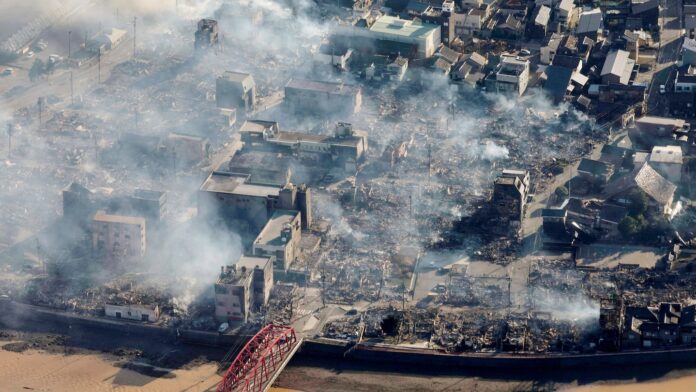“I think everyone remembered March 2011 and the tsunamis, and that’s why there were so many of us [at the mall], probably thousands on each floor,” said Wakabayashi, 33, who paused every few minutes speaking on the phone Tuesday as aftershocks struck.
At least 48 people died, and scores more were injured or missing after the earthquake hit Monday, according to officials. Emergency crews rushed to rescue survivors from the rubble of collapsed buildings and burned homes Tuesday and to send supplies to damaged areas and survivors.
“So far, a large number of casualties, collapsed buildings, fires and other very large-scale damages have been confirmed,” Japanese Prime Minister Fumio Kishida said in a news conference Tuesday. “When it comes to saving lives and rescuing victims, we’re in a battle against time.”
The earthquake prompted the most severe category of tsunami warnings since 2011, when the catastrophic disaster killed at least 18,000 people after waves as high as 130 feet crashed into coastal towns, sweeping away cars and homes, and destroying multistory buildings.
Although all the tsunami warnings were later lifted, the Japan Meteorological Agency warned that more earthquakes with seismic intensities of around 7 could hit seriously affected areas over the coming week, especially the next two to three days. Officials are also concerned about landslides hitting Ishikawa prefecture because rain was forecast there Tuesday night.
Unlike most Asian nations that observe the Lunar New Year — which typically takes place in late January or early February — Japan celebrates the Jan. 1 holiday. The first week of January is typically a sleepy week, when restaurants, grocery stores and even some hospitals are closed for days.
But this year began with blaring tsunami warnings on television and images of destruction from the earthquake, rattling a nation still reeling from the traumatic 2011 disaster. The 9.0-magnitude quake in 2011 — the most powerful recorded in the country’s history — was so strong that NASA believes it may have shifted the Earth’s axis by 6.5 inches.
The earthquake that struck the Noto Peninsula on Monday was the largest recorded there since 1885, when the Japan Meteorological Agency began keeping records.
Naoyuki Kashimi, 67, and his family were walking back home after hatsumode, a traditional new year temple visit, when the shaking began.
“It was really strong, probably the strongest I’ve felt in a while and quite long, too,” said Kashimi, a resident of Kanazawa, the capital of Ishikawa. “I grabbed on to a tree nearby, and many people around me were squatting down. It was really loud, and I could hear the sounds of glass windows rattling.”
Roads were closed after the tsunami warnings, so it took them longer to get home than usual, Kashimi said. Their home was unharmed, and he plans to head to Wajima, a city in Ishikawa that was badly hit by the quake, this week to deliver blankets and other items to residents.
The earthquake caused extensive destruction throughout Ishikawa and surrounding prefectures, according to officials and media reports.
As of Tuesday afternoon, 57,360 people were in evacuation centers, and 10,000 households were without water, Japan’s chief cabinet secretary, Yoshimasa Hayashi, said in a news conference.
More than 100 buildings burned in Wajima, including the Morning Market, one of the oldest in Japan with 200 stalls dating back over 1,300 years.
In Suzu, also in Ishikawa, about 1,000 homes were destroyed. Displaced residents spent the night in shelters. Aerial footage captured an “S.O.S.” sign in the city created out of folding chairs.
“Ninety percent of the houses are completely or almost completely destroyed; the damage is devastating,” Masuhiro Izumiya, mayor of Suzu, said during a disaster response meeting with mayors from the area. “The entire city is in a devastating state.”
Izumiya requested more supplies for the prefecture, saying “there is a shortage of everything: water, food, milk, diapers, feminine hygiene products. Blackouts and water shortage will continue for a while.”
About 33,000 households in the prefecture lost power after the earthquake and remained under a blackout Tuesday, Hayashi said during his news conference. Ishikawa residents had difficulty getting cell service and reaching families they believed were trapped under buildings, he added.
Japan is among the most seismically active countries because of the formation of tectonic plates that meet in the country and its proximity to areas of the Pacific Ocean prone to quakes. It has invested heavily in infrastructure to withstand earthquakes and tsunamis, including concrete sea walls, and Japanese citizens undergo regular drills.
Building codes in Japan have become increasingly strict since major earthquakes in the 1980s and ’90s that killed thousands when buildings collapsed, and the codes were updated again after the March 2011 disaster.
Kishida ordered about 1,000 members of Japan’s Self-Defense Forces to conduct rescue and relief operations and called for a swift response, especially for those buried under rubble.
“We offer our deepest condolences to those who lost their lives. As time goes by, the extent of the damage will become clearer,” Kishida said.



